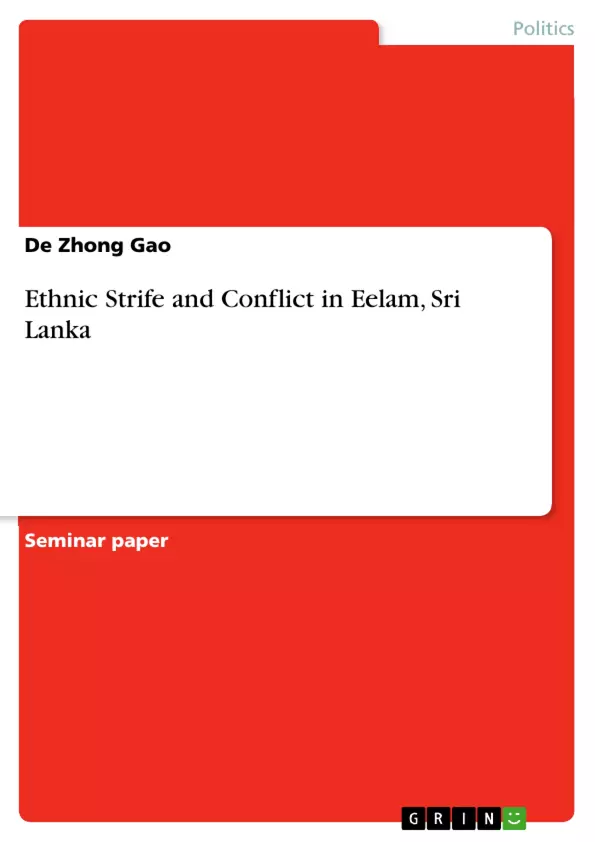Sri Lanka has only recently survived a civil war.Though the conflict is over, questions still arise over whether the country has genuinely facilitated the process of reconstruction and reconciliation of ties across its different ethnic communities.
Where are the origins of the Sinhala-Tamil conflict? This essay will strive to analyze the different socio-ecoonmic, historical and political factors, which have influenced Sinhala-Tamil relations and determined the path of Sri Lanka in the last three decades.
Inhaltsverzeichnis (Table of Contents)
- Introduction
- The Colonial Legacy
- Contemporary Discriminatory Policies
Zielsetzung und Themenschwerpunkte (Objectives and Key Themes)
This essay aims to analyze the root causes of the three-decade-long ethnic conflict in Sri Lanka between the Sinhalese and Tamil communities. It examines the role of both historical factors stemming from British colonial rule and contemporary government policies in exacerbating tensions.
- The impact of British colonial administration and its "divide and rule" policy.
- The role of contemporary government policies in land settlement, language, education, and employment.
- The influence of external social factors in escalating the conflict.
- Analysis of potential alternative solutions for resolving future ethnic conflicts.
- Examination of the Sinhala Only Act of 1956 and its consequences.
Zusammenfassung der Kapitel (Chapter Summaries)
Introduction: This introductory section sets the stage by highlighting the humanitarian crisis and civil war in Sri Lanka, focusing on the ethnic strife between the Sinhalese and Tamil communities. It frames the Sri Lankan conflict as a case study for understanding the failure of democratic negotiations in resolving ethnic conflicts, emphasizing its relevance for newly developing countries. The essay outlines its central argument: the conflict's origins lie in both the British colonial legacy and contemporary discriminatory policies.
The Colonial Legacy: This section delves into the lasting impact of British colonial rule on the Sri Lankan ethnic conflict. The British "divide and rule" policy categorized Ceylon's population into distinct racial groups, creating an uneven power dynamic that favored the Tamils in certain sectors, especially education and government positions. This created resentment among the Sinhalese, who felt unfairly treated. The British favoritism towards the Tamils is presented as a key factor in establishing the early seeds of conflict, highlighting the long-term consequences of colonial policies on inter-ethnic relations.
Contemporary Discriminatory Policies: This section explores how contemporary policies further aggravated pre-existing tensions. The focus shifts to the Sinhala Only Act of 1956, a pivotal moment in the escalation of the conflict. This act, despite constitutional safeguards intended to protect minorities, directly discriminated against the Tamil community, denying them equal opportunities in various sectors. This section also touches upon land settlement, education, and employment policies as additional factors that contributed to the widening rift between the Sinhalese and Tamil communities, ultimately culminating in widespread violence.
Schlüsselwörter (Keywords)
Sri Lanka, ethnic conflict, Sinhalese, Tamil, British colonialism, colonial legacy, discriminatory policies, Sinhala Only Act, land settlement, language rights, education, employment, post-colonial politics, national unity, minority rights, democratic negotiations.
Sri Lankan Ethnic Conflict: A Comprehensive Language Preview - FAQ
What is the main topic of this document?
This document provides a comprehensive overview of the three-decade-long ethnic conflict in Sri Lanka between the Sinhalese and Tamil communities. It analyzes the root causes, exploring both historical factors stemming from British colonial rule and contemporary government policies.
What are the key themes explored in this document?
The key themes include the impact of British colonial administration and its "divide and rule" policy, the role of contemporary government policies in land settlement, language, education, and employment, the influence of external social factors, potential alternative solutions for resolving future ethnic conflicts, and an examination of the Sinhala Only Act of 1956 and its consequences.
What is the central argument of the essay?
The central argument is that the Sri Lankan conflict originates from a combination of the British colonial legacy and contemporary discriminatory policies.
What role did British colonialism play in the conflict?
The British "divide and rule" policy fostered resentment by creating an uneven power dynamic favoring Tamils in certain sectors (education and government). This laid the groundwork for future conflict.
How did contemporary policies exacerbate the conflict?
Contemporary policies, particularly the Sinhala Only Act of 1956, discriminated against the Tamil community, denying them equal opportunities in various sectors. Policies related to land settlement, education, and employment further widened the rift.
What is the significance of the Sinhala Only Act of 1956?
The Sinhala Only Act of 1956 is presented as a pivotal moment in the escalation of the conflict, directly discriminating against the Tamil community despite constitutional safeguards.
What are some potential solutions for resolving future ethnic conflicts discussed in the document?
While not explicitly detailed, the document suggests the need to analyze and address the underlying causes of conflict, including colonial legacies and discriminatory policies, to prevent future conflicts.
What is the structure of the document?
The document includes an introduction, chapters on the colonial legacy and contemporary discriminatory policies, and concludes with a summary and keywords. It also provides a table of contents and clearly stated objectives.
What keywords are associated with this document?
Keywords include: Sri Lanka, ethnic conflict, Sinhalese, Tamil, British colonialism, colonial legacy, discriminatory policies, Sinhala Only Act, land settlement, language rights, education, employment, post-colonial politics, national unity, minority rights, democratic negotiations.
Who is the intended audience for this document?
The document is intended for academic use, focusing on analyzing themes in a structured and professional manner.
- Quote paper
- De Zhong Gao (Author), 2011, Ethnic Strife and Conflict in Eelam, Sri Lanka, Munich, GRIN Verlag, https://www.grin.com/document/188285



